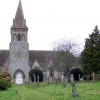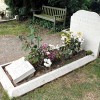It must be one of the most remarkable and intriguing formations of the Jurassic coast. Indeed, so curious and intriguing a natural phenomenon that it has been photographed and reproduced as a living-room landscape picture, one reproduction of which hangs above the mantelpiece in the home of a person of my acquaintance.
But Durdle Door, on the Dorset coast about a mile west of Lulworth Cove, is actually not unique as an example of a geological feature of its type around the thousands of miles of mainland Britain’s coastline. Rather, it represents a process similar to an earlier stage in the formation of sea stacks, those columnar outliers off headlands of bedded rock, examples of which include the Needles off nearby Isle of Wight, and Orkney’s Old Man of Hoy. “Door”, of course, needs no explanation, but the name “Durdle” derives from the Old English Thirl, meaning a bore or drill.
An appropriate starting point for the origin of Durdle Door would be around 140 million years ago during the late Jurassic period, when a shallow, warm sea was just beginning to retreat from southern Britain, leaving behind a lake basin which basked in an equatorial climate. The sea left behind a calcareous deposit which would later become the Portland Limestone series, but the lacustrine environment which succeeded it occupied the area that is now south-east England – but extending west to include Dorset of course – into which the sedimentary deposits of the Purbeck Beds were the first to be laid down. Around this lake tropical ferns and coniferous plants would have flourished and in and around the water dinosaurs would have roamed (saurian footprints have been discovered in a Purbeck quarry).
Without any marked change in the environment the Purbeck beds graded into a series of clays and sands marking the beginning of the Cretaceous period. These were the Wealden beds and Lower Cretaceous Gault Clay and Greensand. Eventually the sea encroached upon the land again, resulting in the deposition, first of a sequence of sands and clays then the unique lime-rich conditions in which the chalk was formed. But how did this sequence of beds come to be where they are today?
In a programme a few years ago devoted to Dorset in the ITV 1 series Countrywise, a geologist astonished presenter Paul Heiney when he explained how Durdle Door came to be formed. He told Heiney that the feature had resulted when the northward-drifting continental plate of Africa collided with that of Europe! In the immediate collision zone, the impact produced the Alps and the Pyrennees, but it also sent a shock wave of compressional movement extending as far north as Britain. This was powerful enough to tilt the earlier Jurassic and Cretaceous strata of southern England almost vertical.
At Durdle Bay nearly all of the limestone has long been removed by wave-action, while the remainder forms the facing of a small headland. This limestone band also forms the submarine “threshold” and seaward cusps of Lulworth Cove, which has been eeked out by wave action on the softer stata behind in a similar way to that of Durdle Bay. It is possible that the “door” was originally a local lens of weaker or softer strata within the limestone which the sea could breach more readily, so forming the archway. Evidently the sea was then able to erode away the rock behind, leaving a gap providing access to beds forming the headland.
Beyond the upstanding limestone it is noticeable that the top of the headland that joins the limestone to the Chalk is not level. From the ground it can be seen that the beds form a col or depression which then passes up into the Chalk forming the cliff-face of the bay behind. This rock, the sequence of the Purbeck beds overlain by the Wealden Beds and Greensand, was less resistant to erosion than the limestone. The dominant rock type in the Purbeck beds is the Purbeck Marble, a calcareous rock consisting almost entirely of brackish or freshwater snails and which has been extensively quarried as a decorative building stone. Interestingly, another feature of the Purbeck is the preservation of stumps originally belonging to some of those tree-ferns that used to grow around 140 million years ago. These can be seen weathered out in The Fossil Forest to the east of the entrance to Lulworth Cove.
Today Durdle Door is under the private ownership of the Weld family as part of their administration of the Lulworth estate. UNESCO teams have for some time been working to conserve the arch and adjoining beach.



